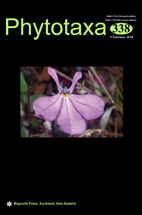Abstract
Matthiola spathulata Conti (1900: 49) was described as a new species in the first monograph of the genus. Apart from the type, which was collected from Iran, no other collections of the species have ever been recorded in the literature (Chernyakovskaya 1939; Cullen 1965; Rechinger 1968; Townsend 1980; Gowler 1998). During a revision of Matthiola W.T.Aiton for the Flora of Iran and neighboring countries, the authors studied many specimens of the genus from NW Iran and southern Armenia that fit the description and type of M. spathulata. Then, in the process of taxonomic studies of this genus, we found that M. iranica Zeraatkar et al. (2016: 145) and M. odoratissima var. dentata Boissier (1867: 149) are conspecific with M. spathulata. The slight differences in leaf morphology, noted in the description of M. odoratissima var. dentata, occurs sometimes throughout most of the range of M. spathulata. Rechinger (1968: 234) considered that M. odoratissima var. dentata and M. farinosa Bunge ex Boissier (1867: 150) as conspecific and cited the type gathering of the former among the studied material of the latter, but no formal synonymy has been proposed by him. Matthiola spathulata is closely related to M. odoratissima W.T.Aiton (1812: 120) but differs in its entire leaves, longer petals, pedicels and fruits (Figs. 1 & 2 M–N; see below). The former is quite different from M. odoratissima in morphological characters and distribution patterns. Matthiola spathulata is distributed in NW Iran and southern Armenia. By contrast, M. odoratissima is mostly distributed along the Black Sea coast (Fig. 2O). Finally, M. spathulata was previously known only from one locality in Iran and is recorded herein for the first time from Armenia.

